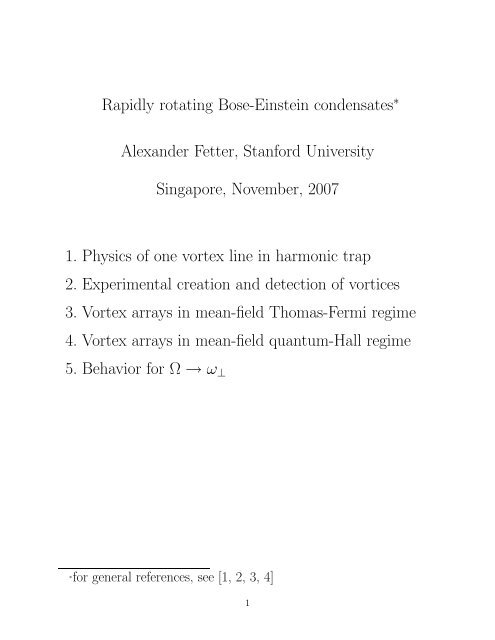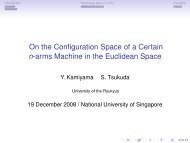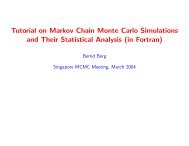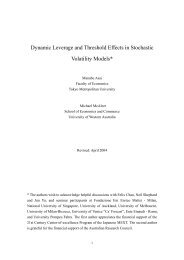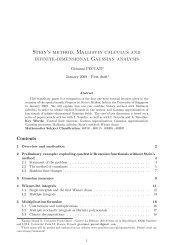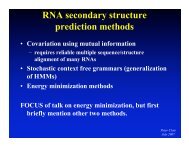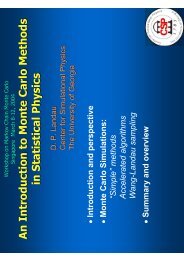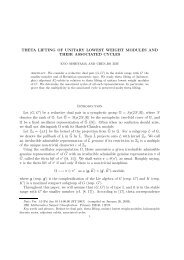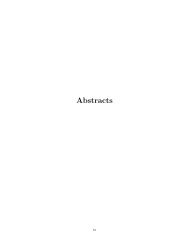Rapidly rotating Bose-Einstein condensatesâ Alexander Fetter ...
Rapidly rotating Bose-Einstein condensatesâ Alexander Fetter ...
Rapidly rotating Bose-Einstein condensatesâ Alexander Fetter ...
You also want an ePaper? Increase the reach of your titles
YUMPU automatically turns print PDFs into web optimized ePapers that Google loves.
<strong>Rapidly</strong> <strong>rotating</strong> <strong>Bose</strong>-<strong>Einstein</strong> condensates ∗<br />
<strong>Alexander</strong> <strong>Fetter</strong>, Stanford University<br />
Singapore, November, 2007<br />
1. Physics of one vortex line in harmonic trap<br />
2. Experimental creation and detection of vortices<br />
3. Vortex arrays in mean-field Thomas-Fermi regime<br />
4. Vortex arrays in mean-field quantum-Hall regime<br />
5. Behavior for Ω → ω ⊥<br />
∗ for general references, see [1, 2, 3, 4]<br />
1
1 Physics of one vortex line in harmonic trap<br />
Assume general axisymmetric trap potential<br />
V tr (r) = V tr (r, z) = 1 2 M ( ω 2 ⊥r 2 + ω 2 zz 2)<br />
Basic idea (Bogoliubov): for weak interparticle potentials,<br />
nearly all particles remain in condensate for T ≪ T c<br />
• for ideal gas at T = 0, all particles are in condensate.<br />
• hence treat occupation of non-condensate as small<br />
• dilute: s-wave scattering length a s ≪ interparticle<br />
spacing n −1/3<br />
• equivalently, require na 3 s ≪ 1<br />
• assume self-consistent condensate wave function Ψ(r)<br />
• gives nonuniform condensate density n(r) = |Ψ(r)| 2<br />
• for T ≪ T c , normalization requires N = ∫ dV |Ψ(r)| 2<br />
2
• assume an energy functional<br />
⎡<br />
∫<br />
E[Ψ] = dV<br />
⎣Ψ ∗ (T + V tr ) Ψ<br />
} {{ }<br />
harmonic oscillator<br />
+ 1 2 g|Ψ|4 } {{ }<br />
2−body term<br />
⎤<br />
⎦ ,<br />
where T = − 2 ∇ 2 /2M is kinetic energy operator<br />
and g = 4πa s 2 /M is interaction coupling parameter<br />
• balance of kinetic energy 〈T 〉 and trap energy 〈V tr 〉<br />
gives mean oscillator length d 0 = √ /Mω 0 where<br />
ω 0 = ( ω 2 ⊥ ω z) 1/3<br />
is geometric mean<br />
• balance of kinetic energy 〈T 〉 and interaction energy<br />
〈gn〉 gives healing length<br />
ξ =<br />
<br />
√ 2Mgn<br />
=<br />
1<br />
√ 8πas n<br />
• with fixed normalization and µ the chemical potential,<br />
variation of E[Ψ] gives Gross-Pitaevskii (GP) eqn<br />
(<br />
T + Vtr + g|Ψ| 2) Ψ = µΨ<br />
• can interpret nonlinear term as a Hartree potential<br />
V H (r) = gn(r), giving interaction with nonuniform<br />
condensate density<br />
3
• generalize to time-dependent GP equation<br />
i ∂Ψ<br />
∂t = (T + V tr + V H ) Ψ<br />
• this result implies that stationary solutions have time<br />
dependence exp(−iµt/)<br />
Introduce hydrodynamic variables<br />
• write Ψ(r,t) = |Ψ(r,t)| exp [iS(r,t)] with phase S<br />
• condensate density is n(r,t) = |Ψ(r,t)| 2<br />
• current is<br />
j =<br />
<br />
2Mi [Ψ∗ ∇Ψ − Ψ∇Ψ ∗ ] = |Ψ| 2 ∇S<br />
M<br />
• identify last factor as velocity v = ∇S/M<br />
• note that v is irrotational so ∇ × v = 0<br />
4
• general property: circulation around contour C is<br />
∮<br />
dl · v = ∮<br />
dl · ∇S = <br />
C M C M ∆S| C<br />
since v = ∇S/M<br />
• change of phase ∆S| C around C must be integer times<br />
2π since Ψ is single-valued<br />
• hence circulation in BEC is quantized in units of κ ≡<br />
2π/M<br />
• rewrite time-dependent GP equation in terms of |Ψ|<br />
and S<br />
– imaginary part gives conservation of particles<br />
∂n<br />
∂t + ∇ · (nv) = 0<br />
– real part gives generalized Bernoulli equation<br />
5
Presence of harmonic trap yields much richer system than<br />
a uniform interacting <strong>Bose</strong> gas [5]<br />
• trap gives new energy scale ω 0 and new length scale<br />
d 0 = √ /Mω 0<br />
• assume repulsive interactions with a s > 0<br />
• trap leads to new dimensionless parameter Na s /d 0<br />
• typical value of ratio of lengths: a s /d 0 ∼ 10 −3<br />
• but Na s /d 0 is large for typical N ∼ 10 6<br />
• in strong repulsive limit (Na s /d 0 ≫ 1), condensate<br />
expands to mean radius R 0 ≫ d 0<br />
• neglect radial gradient of Ψ when R 0 ≫ d 0<br />
• GP equation then simplifies and gives local density<br />
4πa s 2<br />
M<br />
|Ψ(r,z)|2 = µ − V tr (r,z)<br />
[called Thomas-Fermi (TF) limit]<br />
• harmonic trap produces quadratic density variation<br />
with condensate dimensions R 2 j = 2µ/(Mω2 j )<br />
6
One vortex line in trapped BEC<br />
First assume bulk condensate with uniform density n<br />
and a single straight vortex line along z axis<br />
• Gross and Pitaevskii [6, 7]: take condensate wave<br />
function<br />
Ψ(r) = √ ne iφ f (r/ξ)<br />
where r and φ are two-dimensional polar coordinates<br />
• speed of sound is s = √ gn/M<br />
• assume f(0) = 0 and f(r/ξ) → 1 for r ≫ ξ<br />
• velocity has circular streamlines with v = (/Mr) ˆφ<br />
• this is a quantized vortex line with ∮ dl ·v = 2π/M<br />
• v ∼ s when r ∼ ξ, so vortex core forms by cavitation<br />
• equivalently, centrifugal barrier gives vortex core of<br />
radius ξ<br />
7
Static behavior of a vortex line in axisymmetric trap<br />
V tr (r, z) = 1 2 M ( ω 2 ⊥r 2 + ω 2 zz 2)<br />
• If ω z ≫ ω ⊥ , strong axial confinement gives<br />
disk-shaped condensate<br />
• If ω ⊥ ≫ ω z , strong radial confinement gives<br />
cigar-shaped condensate<br />
• for vortex on axis, condensate wave function is<br />
Ψ(r,z) = e iφ |Ψ(r, z)|<br />
• velocity is v = (/Mr) ˆφ, like uniform condensate<br />
• centrifugal energy again forces wave function to vanish<br />
for r ξ<br />
• density is now toroidal; hole along symmetry axis<br />
• TF limit: separated length scales with<br />
ξ (vortex core) ≪ d 0 (mean oscillator length)<br />
d 0 (mean oscillator length) ≪ R 0 (mean condensate radius)<br />
• hence TF density is essentially unchanged by vortex<br />
apart from small hole along the vortex core<br />
8
Energy of <strong>rotating</strong> TF condensate with one vortex<br />
• use density of vortex-free TF condensate; cut off the<br />
logarithmic divergence at core radius ξ<br />
• if condensate is in rotational equilibrium at angular<br />
velocity Ω, the appropriate energy functional is [8]<br />
E ′ [Ψ] = E[Ψ] − Ω · L[Ψ] where L is the angular<br />
momentum<br />
• let E ′ 0 be energy of <strong>rotating</strong> vortex-free condensate<br />
• let E ′ 1(r 0 , Ω) be energy of a <strong>rotating</strong> condensate<br />
with straight vortex that is displaced laterally<br />
by distance r 0 from symmetry axis<br />
• approximation of straight vortex works best for<br />
disk-shaped condensate (ω z ω ⊥ )<br />
• Difference of these two energies is energy associated<br />
with formation of vortex ∆E ′ (r 0 , Ω) = E ′ 1(r 0 , Ω)−E ′ 0<br />
• ∆E ′ (r 0 , Ω) depends on position r 0 of vortex and on Ω<br />
9
Plot ∆E ′ (r 0 , Ω) as function of ζ 0 for various fixed Ω [9],<br />
where ζ 0 = r 0 /R 0 is scaled displacement from center<br />
10
curve (a) is ∆E ′ (r 0 , Ω) for Ω = 0<br />
• ∆E ′ (r 0 , 0) decreases monotonically with increasing ζ 0<br />
• curvature is negative at ζ 0 = 0<br />
• for no dissipation, fixed energy means constant ζ 0<br />
• only allowed motion is uniform precession at fixed r 0<br />
• angular velocity is given by variational Lagrangian<br />
method [10, 11, 3] ˙φ0 ∝ −∂E(r 0 )/∂r 0<br />
• precession arises from nonuniform trap potential (not<br />
image vortex) and nonuniform condensate density<br />
• in presence of weak dissipation, vortex moves to lower<br />
energy and slowly spirals outward<br />
11
As Ω increases, curvature near ζ 0 = 0 decreases<br />
• curve (b) is when curvature near ζ 0 = 0 vanishes<br />
• it corresponds to angular velocity<br />
Ω m = 3 2<br />
<br />
MR 2 ⊥<br />
ln<br />
(<br />
R⊥<br />
• for Ω Ω m , energy ∆E ′ (ζ 0 , Ω) has local minimum<br />
near ζ 0 = 0<br />
• dissipation would now drive vortex back toward the<br />
symmetry axis<br />
• Ω m is angular velocity for onset of metastability<br />
• vortex at center is locally stable for Ω > Ω m , but not<br />
globally stable, since ∆E ′ (0, Ω m ) is positive<br />
ξ<br />
)<br />
12
2 Experimental creation/detection of vortices<br />
in dilute trapped BEC<br />
• first vortex made at JILA (1999) [12]<br />
• use nearly spherical 87 Rb condensate containing two<br />
different hyperfine components<br />
• use coherent (Rabi) process to control interconversion<br />
between two components<br />
• spin up condensate by coupling the two components<br />
with a stirring perturbation<br />
• turn off coupling, leaving one component with trapped<br />
quantized vortex surrounding non<strong>rotating</strong> core of other<br />
component<br />
• use selective tuning to make nondestructive image of<br />
either component<br />
13
• this vortex with large filled core precesses around trap<br />
center<br />
• can also create vortex with (small) empty core [13]<br />
that also precesses<br />
– theory predicts ˙φ/2π ≈ 1.58 ± 0.16 Hz, and<br />
– experiment finds ˙φ/2π ≈ 1.8 ± 0.1 Hz<br />
• see no outward radial motion for ∼ 1 s, so dissipation<br />
is small on this time scale<br />
14
École Normale Supérieure (ENS) in Paris studied vortex<br />
creation in elongated <strong>rotating</strong> cigar-shaped condensate<br />
with one component [14, 15]<br />
• used off-center toggled <strong>rotating</strong> laser beam to deform<br />
the transverse trap potential and stir the condensate<br />
at an applied frequency Ω/2π 200 Hz<br />
• find vortex appears at a critical frequency Ω c ≈ 0.7ω ⊥<br />
(detected by expanding the condensate, which now<br />
has a disk shape, with vortex core as expanded hole)<br />
• vortex nucleation is dynamical process associated with<br />
surface instability (quadrupole oscillation)<br />
15
• ENS group observed small vortex arrays of up to 11<br />
vortices (arranged in two concentric rings)<br />
• like patterns predicted and seen in superfluid 4 He [16]<br />
16
• MIT group has prepared considerably larger <strong>rotating</strong><br />
condensates in less elongated trap<br />
• they have observed triangular vortex lattices with up<br />
to 130 vortices [17]<br />
• like Abrikosov lattice of quantized flux lines (which<br />
are charged vortices) in type-II superconductors<br />
• JILA group has now made large <strong>rotating</strong> condensates<br />
with several hundred vortices and angular velocity<br />
Ω/ω ⊥ ≈ 0.995 [18]<br />
• these rapidly <strong>rotating</strong> systems open many exciting<br />
new possibilities (discussed below)<br />
17
3 Vortex arrays in mean-field Thomas-Fermi<br />
regime<br />
Feynman’s mean vortex density in a <strong>rotating</strong> superfluid<br />
• solid-body rotation has v sb = Ω × r<br />
• v sb has constant vorticity ∇ × v sb = 2Ω<br />
• each quantized vortex at r j has localized vorticity<br />
∇ × v = 2π<br />
M δ(2) (r − r j ) ẑ<br />
• assume N v vortices uniformly distributed in area A<br />
bounded by contour C<br />
• circulation around C is N v × 2π/M<br />
• but circulation in A is also 2ΩA<br />
• hence vortex density is n v = N v /A = MΩ/π<br />
• area per vortex 1/n v is π/MΩ ≡ πl 2 which defines<br />
radius l = √ /MΩ of circular cell<br />
• intervortex spacing ∼ 2l decreases like 1/ √ Ω<br />
• analogous to quantized flux lines (charged vortices) in<br />
type-II superconductors<br />
18
As Ω increases, the mean vortex density n v = MΩ/π<br />
increases linearly following the Feynman relation<br />
• in addition, centrifugal forces expand the condensate<br />
radially, so that the area πR⊥ 2 also increases<br />
• hence the number of vortices N v = n v πR 2 ⊥ = MΩR2 ⊥ /<br />
increases faster than linearly with Ω<br />
• conservation of particles implies that the condensate<br />
also shrinks axially<br />
• TF approximation assumes that interaction energy<br />
〈g|Ψ| 4 〉 and trap energy 〈V tr |Ψ| 2 〉 are large relative to<br />
kinetic energy for density variations ( 2 /M)〈(∇|Ψ|) 2 〉<br />
• radial expansion of <strong>rotating</strong> condensate means that<br />
central density eventually becomes small<br />
19
Quantitative description of <strong>rotating</strong> TF condensate<br />
Kinetic energy of condensate involves<br />
2 ∫ ∫<br />
dV |∇Ψ| 2 = dV 1 2M<br />
2 Mv2 |Ψ| 2<br />
} {{ }<br />
superflow energy<br />
∫<br />
dV (∇|Ψ|) 2<br />
}<br />
2M<br />
{{ }<br />
density variation<br />
+ 2<br />
where Ψ = exp(iS)|Ψ| and v = ∇S/M is flow velocity<br />
• generalized TF approximation: retain the energy of<br />
superflow but ignore the energy from density variation<br />
• this approximation will fail eventually when vortex<br />
lattice becomes dense and cores start to overlap<br />
• in <strong>rotating</strong> frame, generalized TF energy functional is<br />
∫<br />
E ′ [Ψ] = dV [( 1<br />
2 Mv2 + V tr − MΩ · r × v ) |Ψ| 2<br />
+ 1 2 g|Ψ|4]<br />
• here, v is flow velocity generated by all the vortices<br />
20
For Ω along z, can complete square and rewrite E ′ [Ψ] as<br />
⎡<br />
∫<br />
)<br />
E ′ [Ψ] = dV ⎣ 1 2 (v<br />
2 M } −{{ Ω × r}<br />
|Ψ| 2 + 1 2 Mω2 zz 2 |Ψ| 2<br />
v−v sb<br />
+ 1 2 M ( ω 2 ⊥ − Ω 2) r 2 |Ψ| 2 + 1 2 g|Ψ|4 ]<br />
• in the <strong>rotating</strong> frame, the dominant effect of the dense<br />
vortex array is that spatially averaged flow velocity v<br />
is close to Ω × r = v sb<br />
• hence can ignore first term in E ′ [Ψ], giving<br />
∫ [ 1<br />
E ′ [Ψ] ≈ dV<br />
2 Mω2 zz 2 |Ψ| 2 + 1 2 M ( ω⊥ 2 − Ω 2) r 2 |Ψ| 2<br />
+ 1 2 g|Ψ|4 ]<br />
• E ′ now looks exactly like TF energy for non<strong>rotating</strong><br />
condensate but with a reduced radial trap frequency<br />
ω 2 ⊥ → ω2 ⊥ − Ω2 21
Hence TF wave function depends explicitly on Ω through<br />
the altered radial trap frequency ω⊥ 2 → ω2 ⊥ − )<br />
Ω2<br />
|Ψ(r, z)| 2 = n(0)<br />
(1 − r2<br />
− z2<br />
Rz<br />
2<br />
where<br />
R 2 ⊥ =<br />
2µ<br />
M(ω 2 ⊥ − Ω2 )<br />
R 2 ⊥<br />
and R 2 z = 2µ<br />
Mω 2 z<br />
• for pure harmonic trap, must have Ω < ω ⊥ to retain<br />
radial confinement<br />
• normalization ∫ dV |Ψ| 2 = N shows that<br />
( ) 2/5<br />
µ(Ω)<br />
µ(0) = 1 − Ω2<br />
ω⊥<br />
2<br />
in three dimensions<br />
• central density given by n(0) = µ(Ω)/g<br />
• n(0) decreases with increasing Ω because of reduced<br />
radial confinement<br />
22
• TF formulas for condensate radii show that<br />
( ) 1/5 (<br />
R z (Ω)<br />
R z (0) = 1 − Ω2 R ⊥ (Ω)<br />
ω⊥<br />
2 ,<br />
R ⊥ (0) = 1 − Ω2<br />
ω⊥<br />
2<br />
confirming axial shrinkage and radial expansion<br />
• for nonzero Ω, aspect ratio changes<br />
R z (Ω)<br />
R ⊥ (Ω) = √<br />
ω<br />
2<br />
⊥<br />
− Ω 2<br />
ω z<br />
) −3/10<br />
• this last effect provides an important diagnostic tool<br />
to determine actual angular velocity Ω [19, 18]<br />
• measured aspect ratio [18] indicates that Ω/ω ⊥ can<br />
become as large as ≈ 0.993<br />
23
How uniform is the vortex array?<br />
The analysis of the TF density profile |Ψ TF | 2 = n TF in<br />
the <strong>rotating</strong> condensate assumed that the flow velocity v<br />
was precisely the solid-body value v sb = Ω × r<br />
• this led to the cancellation of the contribution<br />
∫<br />
dV (v − Ω × r) 2 n TF<br />
in the TF energy functional<br />
• a more careful study [20] shows that there is a small<br />
nonuniformity in the vortex lattice<br />
• specifically, each regular vortex lattice position vector<br />
r j experiences a small displacement field u(r), so that<br />
r j → r j + u(r j )<br />
• as a result, the two-dimensional vortex density changes<br />
to<br />
n v (r) ≈ n v (1 − ∇ · u)<br />
where n v = MΩ/π is the uniform Feynman value<br />
24
• variation with respect to u yields an Euler-Lagrange<br />
equation that can be solved to give<br />
u(r) ≈ ¯l 2 ( ) ¯l2 r<br />
4R⊥<br />
2 ln<br />
ξ 2 1 − r 2 /R⊥<br />
2<br />
where π¯l 2 = 1/n v can be taken as the area of a circular<br />
vortex cell inside the slowly varying logarithm<br />
• the deformation of the regular vortex lattice is purely<br />
radial (as expected from symmetry)<br />
• R 2 ⊥ /¯l 2 is the number of vortices N v in the <strong>rotating</strong><br />
condensate, so that the nonuniform distortion is small,<br />
of order 1/N v (at most a few %), even though the TF<br />
number density n TF changes dramatically near edge<br />
• correspondingly, the vortex density becomes<br />
n v (r) ≈ n v − 1 ( ) ¯l2 1<br />
2πR⊥<br />
2 ln<br />
ξ 2 (1 − r 2 /R⊥ 2 )2<br />
(the correction is again of order 1/N v )<br />
25
• recent JILA experiments [21] confirm these predicted<br />
small distortions for relatively dense vortex lattices<br />
[note suppressed zero for Figs. (a)-(d); Fig. (e) shows<br />
that effect is small]<br />
26
Tkachenko oscillations of the vortex lattice<br />
Tkachenko (1966) [22] studied equilibrium arrangement<br />
of a <strong>rotating</strong> vortex array as model for superfluid 4 He<br />
• assumed two-dimensional incompressible fluid with straight<br />
vortices<br />
• showed that a triangular lattice has lowest energy in<br />
<strong>rotating</strong> frame<br />
• small perturbations about equilibrium positions had<br />
unusual collective motion in which vortices undergo<br />
nearly transverse wave of lattice distortions (like twodimensional<br />
transverse “phonons” in vortex lattice,<br />
but with no change in fluid density)<br />
• for long wavelengths (small k), Tkachenko found a<br />
linear dispersion relation ω k ≈ c T k<br />
√<br />
1<br />
• speed of Tkachenko wave c T =<br />
4 Ω/M = 1 2 /M¯l,<br />
where ¯l = √ /MΩ is radius of circular vortex cell<br />
27
In a <strong>rotating</strong> two-dimensional gas, the compressibility<br />
becomes important, as shown by Sonin [23, 24] and Baym [25]<br />
• let the speed of sound in the compressible gas be c s<br />
• coupling between the vortices and the compressible<br />
fluid leads to generalized dispersion relation<br />
ω 2 = c 2 T<br />
c 2 sk 4<br />
4Ω 2 + c 2 sk 2<br />
• if c s k ≫ Ω, recover Tkachenko’s result ω = c T k<br />
(short-wavelength incompressible limit)<br />
• but if c s k ≪ Ω (long wavelength), mode becomes soft<br />
with ω ∝ k 2<br />
• Sonin [24] obtains dynamical equations for waves in a<br />
nonuniform condensate, along with appropriate<br />
boundary conditions at the outer surface<br />
• Baym [25] uses theory for uniform condensate plus<br />
approximate boundary conditions from Anglin and<br />
Crescimanno [26]<br />
28
• rough agreement with JILA experiments [27] on<br />
low-lying Tkachenko modes in rapidly <strong>rotating</strong> BEC<br />
(up to Ω/ω ⊥ ≈ 0.975)<br />
• A is 1/4 period after weak perturbation<br />
(note deformation of lines of vortices)<br />
• B is 3/4 period after weak perturbation<br />
(note reversed deformation of lines of vortices)<br />
29
4 Vortex arrays in mean-field quantum-Hall<br />
regime<br />
Lowest-Landau-Level (quantum-Hall) behavior<br />
When the vortex cores overlap, kinetic energy associated<br />
with density variation around each vortex core becomes<br />
important<br />
• hence the TF approximation breaks down (it ignores<br />
this kinetic energy from density variations)<br />
• return to full GP energy E ′ [Ψ] in the <strong>rotating</strong> frame.<br />
• in this limit of rapid rotations (Ω ω ⊥ ), Ho [28]<br />
incorporated kinetic energy exactly<br />
• condensate expands and is effectively two dimensional<br />
• for simplicity, treat a two-dimensional condensate that<br />
is uniform in the z direction over a length Z<br />
• condensate wave function Ψ(r,z) can be written as<br />
√<br />
N/Z ψ(r), where ψ(r) is a two-dimensional wave<br />
function with unit normalization ∫ d 2 r |ψ| 2 = 1<br />
30
General two-dimensional energy functional in <strong>rotating</strong> frame<br />
becomes<br />
⎛<br />
⎞<br />
∫<br />
E ′ [ψ] = d 2 r ψ ∗ ⎜<br />
p 2<br />
⎝2M + 1 2 Mω2 ⊥r 2 − ΩL z + 1<br />
} {{ } 2 g 2D|ψ| 2 ⎟<br />
⎠<br />
} {{ }<br />
ψ,<br />
one−body oscillator H 0 interaction<br />
where p = −i∇, L z = ẑ · r × p, and g 2D = Ng/Z<br />
One-body oscillator hamiltonian in <strong>rotating</strong> frame H 0 is<br />
exactly soluble and has eigenvalues [29]<br />
ɛ nm = [ω ⊥ + n (ω ⊥ + Ω) + m (ω ⊥ − Ω)]<br />
where n and m are non-negative integers<br />
• in limit Ω → ω ⊥ , these eigenvalues are essentially<br />
independent of m (massive degeneracy)<br />
• n becomes the Landau level index<br />
• lowest Landau level with n = 0 is separated from<br />
higher states by gap ∼ 2ω ⊥<br />
31
Large radial expansion means small central density n(0),<br />
so that interaction energy gn(0) eventually becomes small<br />
compared to gap 2ω ⊥<br />
Hence focus on “lowest Landau level” (LLL), with n = 0<br />
and general non-negative m ≥ 0<br />
• ground-state wave function is Gaussian ψ 00 ∝ e −r2 /2d 2 ⊥<br />
• general LLL eigenfunctions have a very simple form<br />
ψ 0m (r) ∝ r m e imφ e −r2 /2d 2 ⊥<br />
• here, d ⊥ = √ /Mω ⊥ is analogous to the “magnetic<br />
length” in the Landau problem<br />
• in terms of a complex variable ζ ≡ x + iy, these LLL<br />
eigenfunctions become<br />
ψ 0m ∝ ζ m e −r2 /2d 2 ⊥ ∝ ζ m ψ 00<br />
with m ≥ 0 (note that ζ = r e iφ when expressed in<br />
two-dimensional polar coordinates)<br />
• apart from ground-state Gaussian ψ 00 , this is just ζ m<br />
(a non-negative power of the complex variable)<br />
32
• assume that the GP wave function is a finite linear<br />
combination of these LLL eigenfunctions<br />
ψ LLL (r) = ∑ m≥0c m ψ 0m (r) = f(ζ) e −r2 /2d 2 ⊥<br />
where f(ζ) = ∑ m≥0 c m ζ m is an analytic function of<br />
the complex variable ζ<br />
• specifically, f(ζ) is a complex polynomial and thus<br />
can be factorized as f(ζ) = ∏ j (ζ − ζ j) apart from<br />
overall constant<br />
• f(ζ) vanishes at each of the points {ζ j }, which are<br />
the positions of the zeros of ψ LLL<br />
• in addition, phase of wave function increases by 2π<br />
whenever ζ moves around any of these zeros {ζ j }<br />
• we conclude that the LLL trial solution has singly<br />
quantized vortices located at positions of zeros {ζ j }<br />
• basic conclusion: vortices are nodes in the condensate<br />
wave function<br />
33
• spatial variation of number density n(r) = |ψ LLL (r)| 2<br />
is determined by spacing of the vortices<br />
• core size is comparable with the intervortex spacing<br />
¯l = √ /MΩ which is simply d ⊥ in the limit Ω ≈ ω ⊥<br />
• unlike TF approximation at lower Ω, wave function<br />
ψ LLL automatically includes all the kinetic energy<br />
• since LLL wave functions play a crucial role in the<br />
quantum Hall effect (two-dimensional electrons in a<br />
strong magnetic field), this LLL regime has been called<br />
“mean-field quantum-Hall” limit [30]<br />
• note that we are still in the regime governed by GP<br />
equation, so there is still a BEC<br />
• corresponding many-body ground state is simply a<br />
Hartree product with each particle in same one-body<br />
solution ψ LLL (r), namely<br />
Ψ GP (r 1 ,r 2 , · · · ,r N ) ∝<br />
N∏<br />
ψ LLL (r n )<br />
n=1<br />
• this is coherent (superfluid) state, since a single GP<br />
state ψ LLL has macroscopic occupation<br />
34
Take this LLL trial function seriously<br />
• for any LLL state ψ LLL that is linear combination of<br />
ψ 0m , can show that (use oscillator units with ω ⊥ and<br />
d ⊥ for energy and length) [28, 30, 31]<br />
∫<br />
∫<br />
d 2 r r 2 |ψ LLL | 2 = 1 + d 2 r ψLLLL ∗ z ψ LLL<br />
namely Mω ⊥ 〈r 2 〉 = + 〈L z 〉 in dimensional units<br />
• dimensionless energy functional becomes<br />
∫<br />
E ′ [ψ LLL ] = Ω+ d 2 r [ (1 − Ω) r 2 |ψ LLL | 2 + 1 2 g 2D|ψ LLL | 4]<br />
• unrestricted variation with respect to |ψ| 2 would lead<br />
to inverted parabola<br />
|ψ| 2 = n(r) = 2 ) (1<br />
πR0<br />
2 − r2<br />
R0<br />
2<br />
where πR 4 0 = 2g 2D /(1 − Ω) fixes condensate radius<br />
• looks like earlier TF profile, but here include all kinetic<br />
energy explicitly<br />
• these results ignore vortices and violate form of ψ LLL<br />
35
• to include effect of vortices, study logarithm of the<br />
particle density for any LLL state<br />
• use ψ LLL to find<br />
lnn LLL (r) = − r2<br />
d 2 ⊥<br />
+ 2 ∑ j<br />
ln |r − r j |<br />
where r j is the position of the jth vortex<br />
• apply two-dimensional Laplacian: use standard result<br />
∇ 2 ln |r − r j | = 2πδ (2) (r − r j ) to obtain<br />
∇ 2 ln n LLL (r) = − 4<br />
d 2 ⊥<br />
+ 4π ∑ j<br />
δ (2) (r − r j )<br />
• here, sum over delta functions is precisely the vortex<br />
density n v (r)<br />
• this result relates particle density n LLL (r) in LLL<br />
approximation to vortex density n v (r) [28, 30, 31]<br />
n v (r) = Mω ⊥<br />
π + 1<br />
4π ∇2 ln n LLL (r)<br />
36
• if vortex lattice is exactly uniform (so n v is constant),<br />
then density profile is strictly Gaussian,<br />
with n LLL (r) ∝ exp(−r 2 /σ 2 ) and<br />
σ −2 = Mω ⊥ / − πn v = M(ω ⊥ − Ω)/<br />
• note that σ 2 ≫ d 2 ⊥<br />
, so that this resulting Gaussian is<br />
much bigger than original ground stat<br />
• to better minimize the energy, mean density profile<br />
n LLL should approximate inverted parabolic shape<br />
n LLL (r) ∝ 1 − r 2 /R 2 ⊥<br />
• then find nonuniform vortex density with<br />
n v (r) ≈ 1<br />
πd 2 ⊥<br />
− 1<br />
πR 2 ⊥<br />
1<br />
(1 − r 2 /R 2 ⊥ )2<br />
similar to result at lower Ω [20] (in both cases, small<br />
correction term is of order ∼ N −1<br />
v )<br />
• independently, numerical work by Cooper et al. [32]<br />
shows that allowing the vortices in the LLL to deviate<br />
from the triangular array near the outer edge lowers<br />
the energy<br />
37
5 Behavior for Ω → ω ⊥<br />
What happens beyond the “mean-field quantum Hall”<br />
regime is still subject to vigorous debate<br />
Predict quantum phase transition from coherent BEC<br />
states to various correlated many-body states<br />
• define the ratio ν ≡ N/N v = the number of atoms<br />
per vortex<br />
• because of similarities to a two-dimensional electron<br />
gas in a strong magnetic field, ν is called the “filling<br />
fraction” [33, 34]<br />
• current experiments [18] have N ∼ 10 5 and N v ∼<br />
several hundred, so ν ∼ a few hundred<br />
• numerical studies [34] for small number of vortices<br />
(N v 8) and variable N indicate that the coherent<br />
GP state is favored for ν 6 − 8<br />
• softening of Tkachenko spectrum for rapid rotation<br />
can induce melting of vortex lattice at similar filling<br />
fraction ν [35, 36]<br />
38
• in either scenario, BEC and the associated coherent<br />
state disappears at a quantum phase transition for<br />
ν ∼ 5-10<br />
• replaced by qualitatively different correlated states<br />
that are effectively incompressible vortex liquids<br />
• for smaller ν, there is a sequence of highly correlated<br />
states similar to some known from the quantum Hall<br />
effect<br />
• in particular, theorists have proposed boson version<br />
of the Laughlin state [34] (here z n = x n + iy n refers<br />
to nth particle)<br />
( )<br />
N∏<br />
N∑<br />
Ψ Lau (r 1 , r 2 , · · · , r N ) ∝ (z n − z n ′) 2 |z n | 2<br />
exp −<br />
2d 2 n
Note: these correlated many-body states are qualitatively<br />
different from the coherent GP state<br />
• the GP state Ψ GP (r 1 , r 2 , · · · , r N ) ∝ ∏ n ψ(r n) is<br />
the Hartree product of N factors of same one-body<br />
function ψ(r)<br />
• in the Laughlin state Ψ Lau (r 1 ,r 2 , · · · , r N ), the 2-body<br />
product ∏ n
What is physics of this phase transition?<br />
Why does it occur for relatively large ν ∼ 10?<br />
• for small N and large L (namely small ν), exact<br />
ground states have correlated form [33]<br />
• different symmetry of ground states for small and<br />
large ν requires a quantum phase transition at some<br />
intermediate critical ν c<br />
• For N particles in two dimensions, there are 2N<br />
degrees of freedom<br />
• each vortex has one collective degree of freedom<br />
• hence N v vortices have N v collective degrees of<br />
freedom<br />
• usually treated as additive, but in fact only<br />
2N − N v particle degrees of freedom remain<br />
• for N ≫ N v (namely large ν), depletion of particle<br />
degrees is unimportant<br />
• eventually, when N v is a finite fraction of N (namely<br />
ν ∼ 10), original description fails and get transition<br />
to new correlated ground state<br />
41
How to reach the highly correlated regime?<br />
• need to reduce the ratio ν = N/N v (number of atoms<br />
per vortex)<br />
• very challenging since need small N 100 and<br />
rapid rotation Ω 0.999ω ⊥<br />
• one possibility is to use one-dimensional array of small<br />
pancake condensates trapped in optical lattice<br />
• need to rotate each condensate to a relatively high<br />
angular velocity<br />
• several experimental groups working on this option<br />
42
References<br />
[1] F. Dalfovo, S. Giorgini, L. P. Pitaevskii and S. Stringari,<br />
Rev. Mod. Phys. 71, 463 (1999).<br />
[2] A. L. <strong>Fetter</strong>, in <strong>Bose</strong>-<strong>Einstein</strong> Condensation in Atomic Gases,<br />
edited by M. Inguscio, S. Stringari and C. E. Wieman (IOP<br />
Press, Amsterdam, 1999), p. 201.<br />
[3] A. L. <strong>Fetter</strong> and A. A. Svidzinsky, J. Phys.: Condens. Matter<br />
13, R135 (2001).<br />
[4] A. L. <strong>Fetter</strong>, J. Low Temp. Phys. 129, 263 (2002).<br />
[5] G. Baym and C. J. Pethick, Phys. Rev. Lett. 76, 6 (1996).<br />
[6] E. P. Gross, Nuovo Cimento 20, 454 (1961).<br />
[7] L. P. Pitaevskii, Zh. Eksp. Teor. Fiz. 40, 646 (1961)<br />
[Sov. Phys. JETP 13, 451 (1961)].<br />
[8] L. D. Landau and E. M. Lifshitz, Mechanics, Pergamon Press,<br />
Oxford (1960); E. M. Lifshitz and L. P. Pitaevskii, Statistical<br />
Physics, Pergamon Press, Oxford (1980).<br />
[9] A. A. Svidzinsky and A. L. <strong>Fetter</strong>, Phys. Rev. Lett. 84, 5919<br />
(2000).<br />
[10] E. Lundh and P. Ao, Phys. Rev. A 61, 063612 (2000).<br />
[11] S. A. McGee and M. J. Holland, Phys. Rev. A 63, 043608 (2001).<br />
[12] M. R. Matthews, B. P. Anderson, P. C. Haljan, D. S. Hall, C. E.<br />
Wieman and E. A. Cornell, Phys. Rev. Lett. 83, 2498 (1999).<br />
[13] B. P. Anderson, P. C. Haljan, C. E. Wieman, and E. A. Cornell,<br />
Phys. Rev. Lett. 85, 2857 (2000).<br />
43
[14] K. W. Madison, F. Chevy, W. Wohllenben and J. Dalibard,<br />
Phys. Rev. Lett. 84, 806 (2000).<br />
[15] K. W. Madison, F. Chevy, W. Wohllenben and J. Dalibard,<br />
J. Mod. Opt. 47, 2725 (2000).<br />
[16] E. J. Yarmchuk, M. J. V. Gordon, and R. E. Packard, Phys.<br />
Rev. Lett. 79, 214 (1979).<br />
[17] J. R. Abo-Shaeer, C. Raman, J. M. Vogels, and W. Ketterle,<br />
Science 292, 476 (2001).<br />
[18] V. Schweikhard, I. Coddington, P. Engels, V.P. Mogendorff, and<br />
E. A. Cornell, Phys. Rev. Lett. 92, 040404 (2004).<br />
[19] P. C. Haljan, I. Coddington, P. Engels, and E. A. Cornell,<br />
Phys. Rev. Lett. 87, 210403 (2001).<br />
[20] D. E. Sheehy and L. Radzihovsky, Phys. Rev. A 70, 051602(R)<br />
(2004); Phys. Rev. A 70, 063620 (2004) .<br />
[21] I. Coddington, P. C. Haljan, P. Engels, V. Schweikhard, S. Tung,<br />
and E. A. Cornell, Phys. Rev. A 70, 063607 (2004).<br />
[22] V. K. Tkachenko, Zh. Eksp. Teor. Fiz. 49, 1875 (1965)<br />
[Sov. Phys. JETP 22, 1282 (1966)]; Zh. Eksp. Teor. Fiz. 50,<br />
1573 (1966) [Sov. Phys. JETP 23, 1049 (1966)].<br />
[23] E. B. Sonin, Rev. Mod. Phys. 59, 87 (1987).<br />
[24] E. B. Sonin, Phys. Rev. A 71, 011603(R) (2005).<br />
[25] G. Baym, Phys. Rev. Lett. 91, 110402 (2003).<br />
[26] J. R. Anglin and M. Crescimanno, cond-mat/0210063.<br />
44
[27] I. Coddington, P. Engels, V. Schweikhard and E. A. Cornell,<br />
Phys. Rev. Lett. 91, 100402 (2003).<br />
[28] T.-L. Ho, Phys. Rev. Lett. 87, 060403 (2001).<br />
[29] C. Cohen-Tannoudji, B. Diu and F. Laloë, Quantum Mechanics<br />
(J. Wiley & Sons, New York, 1977), Volume I, pp. 742-764.<br />
[30] G. Watanabe, G. Baym, and C. J. Pethick, Phys. Rev. Lett. 93,<br />
190401 (2004).<br />
[31] A. Aftalion, X. Blanc, and J. Dalibard, Phys. Rev. A 71, 023611<br />
(2005).<br />
[32] N. R. Cooper, S. Komineas, and N. Read, Phys. Rev. A 70,<br />
033604 (2004).<br />
[33] N. K. Wilkin and M. J. F. Gunn, Phys. Rev. Lett. 84, 6 (2000).<br />
[34] N. R. Cooper, N. K. Wilkin, and M. J. F. Gunn, Phys. Rev.<br />
Lett. 87, 120405 (2001).<br />
[35] J. Sinova, C. B. Hanna, and A. H. MacDonald, Phys. Rev. Lett.<br />
89, 030403 (2002).<br />
[36] G. Baym, Phys. Rev. A 69, 043618 (2004).<br />
45


